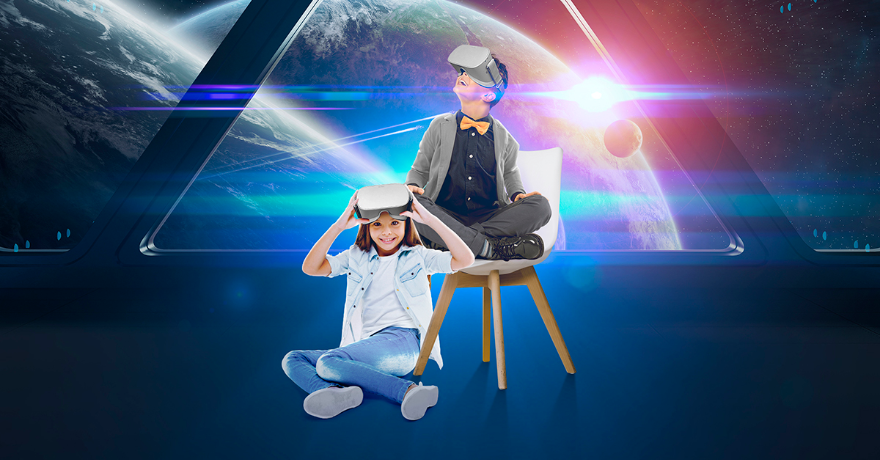VRIT - VR group, immediate test
VRRT - VR group, retention test
CIT - Controlled group, immediate test
CRT - Controlled group, retention test
VR expansion in education
In this article based on Beijing Bluefocus E-Commerce Case Study we are going to show you some significant results on how Virtual Reality can affect on student's academic performance.
2016, known as the Virtual Reality boom year, has seen Virtual Reality emerging in enormous popularity in China. VR industry grows, the importance of VR content is more and more valued, VR content creators are not limiting their focus on games, that's why some of them intend to expand VR application to education. VR-based education considered as a field with huge potentials and has evolved from "concept phase" to "implementation phase".
Compared with traditional education, VR-based education is of obvious advantage in theoretical knowledge teaching as well as practical skills training.
When it comes to theoretical knowledge teaching, VR shows the ability to make abstract problems concrete, and support theoretical thinking. In practical skills training, it helps with students' operational skills, provides an immersive learning experience, and enhances students' sense of involvement in class, making learning more fun, more secure, and more active.

VR Improves Test Scores - Results
In Beijing Bluefocus E-Commerce Case Study the average score of the VRIT group is 93, CIT, 73. On average, VRIT group has registered a 27.4% growth in terms of score, indicating the great advantage of VR in the teaching of astrophysics.
As astrophysics is a science which students cannot really do experiments in class, they can only try to understand it by their imagination or teachers' explanation.
However, VR-based teaching makes it possible to present to students the abstract aerospace in three dimensions, conduct simulated operations and let students experience the scenarios at different cosmic velocity.
VR-based teaching is vivid and interactive. It helps students get better test scores by enhancing their ability of understanding and memorizing knowledge.
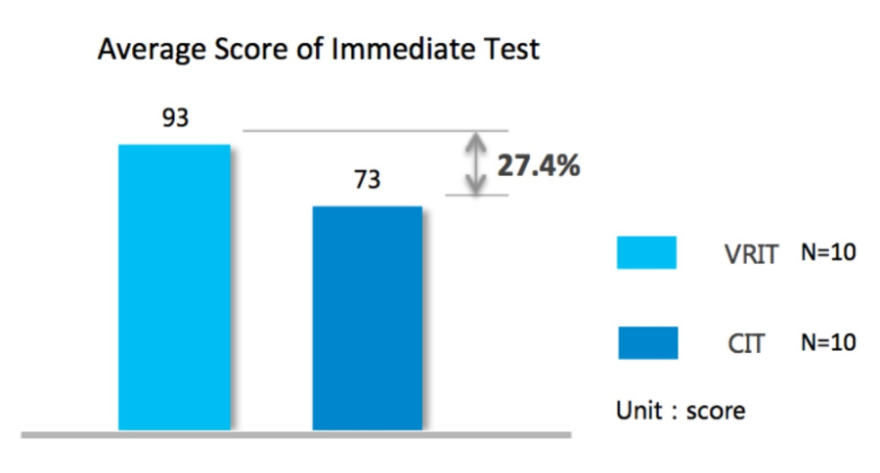
Students from each grade level achieved more progress by VR-based learning than traditional teaching; With the help of VR-based teaching, the average score of the grade level C group is better than Grade A level group who are taught by traditional teaching.
In the VR-based teaching group, the average score of Grade A, B, and C are respectively 98, 92 and 88, which are obviously higher that their counterparts taught by a traditional mode. The average score of Grade C group reaches 88, 15.7% more than that of the Grade A group taught by traditional mode, suggesting that students who are at relative low score could possibly achieve high score with the help of VR-based teaching in some specific subjects.
By trigger students' interest of learning, VR makes students more willing to learn. What's more, VR-based teaching could make students more attentive, more easily to accumulate knowledge, and finally to improve their test scores.
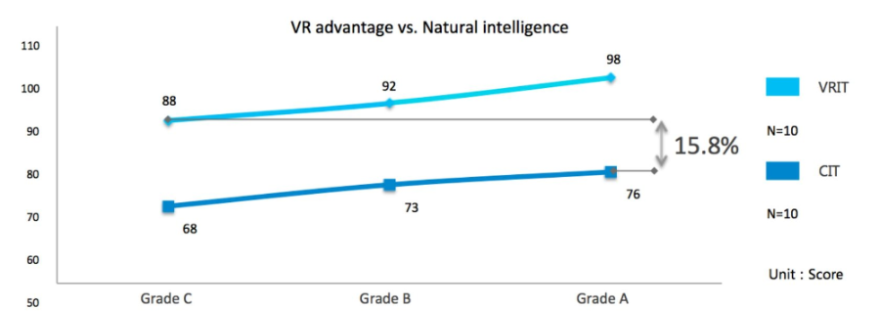
In Retention Test, the average score of VR group is 90, while that of the traditional teaching group is 68. The gap between the two average scores is 32.4%, suggesting that knowledge taught in traditional mode is more tended to be forgotten, while VR-based teaching could help students get a greater impression and improve long-term memory because it creates real environment, interacts with students and make students more involved in the teaching.
Advantages of VR Teaching
VR has some obvious advantages in teaching, for example, it make the content of courses more vivid; students can experience by themselves; it is very interactive, and is easy to remember and understand.
As traditional teaching plays a weak role in igniting students' learning interest, VR-based teaching inspires students to learn and presents to students the abstract content occurred in the learning process in a vivid way, making it easier for students to understand and retain knowledge.
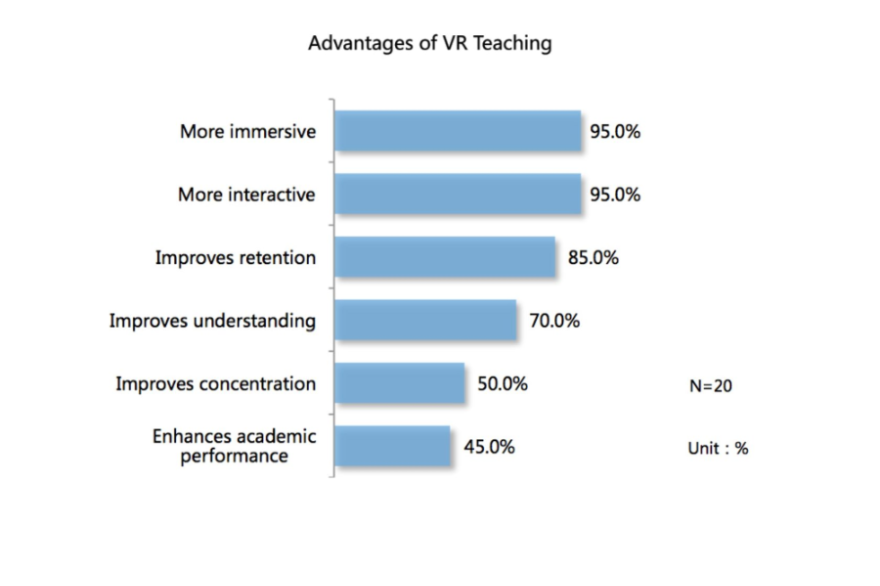
Students who participate in Beijing Bluefocus E-Commerce Case Study hope that VR can be applied to physics, biology and chemistry. However, this might be a result of lack of VR education contents in other subjects at this moment.
Our previous article shows that the immersive VR-based teaching is of great help to language learning. According to VR English teaching pioneers, VR is very suitable for English teaching, because for most people in China, English is a skill rather than a science. (you can also read about the role of Virtual Reality in language learning in our previous article in this blog).
The acquisition of a skill lies in natural practice, not in the accumulation of knowledge. Students should learn the skill by simulating a vivid and natural environment where they can learn, observe and memorize in a natural and efficient way.
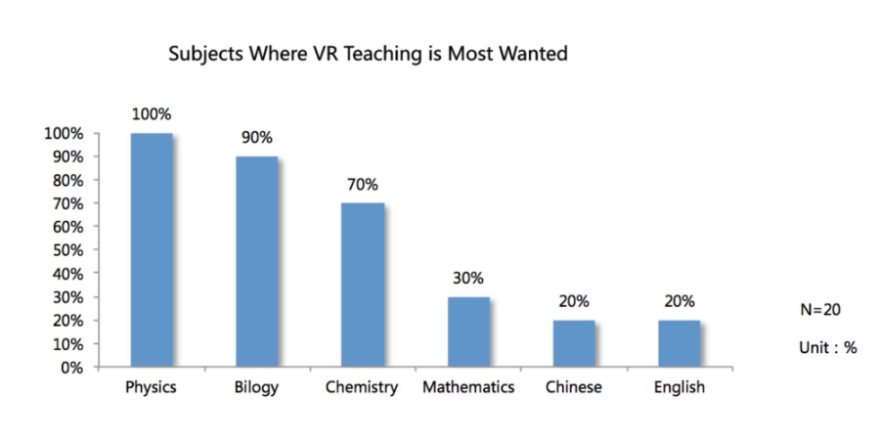
The right teaching method unlocks students' potentials. In Beijing Bluefocus E-Commerce experiment, they have made another interesting finding.
The average score of the Grade C students in VR group reached 88. This result is 15.8% higher than that of the Grade A students in Controlled group. As authors of experiment have found, the right teaching method helps to discover children's unlimited potentials.
Besides astrophysics, VR-based teaching will be of great value in the teaching of subjects like chemistry and biology. Subjects whose contents cannot be easily visualized in real life are great areas for VR to play its magic.
Things that are tiny and cannot be seen with bare eyes in real life, such as molecule, atomic structure, cells, the solar system and the galaxy can all be visualized in VR, transforming abstract and conceptual perceptions to concrete images and objects.
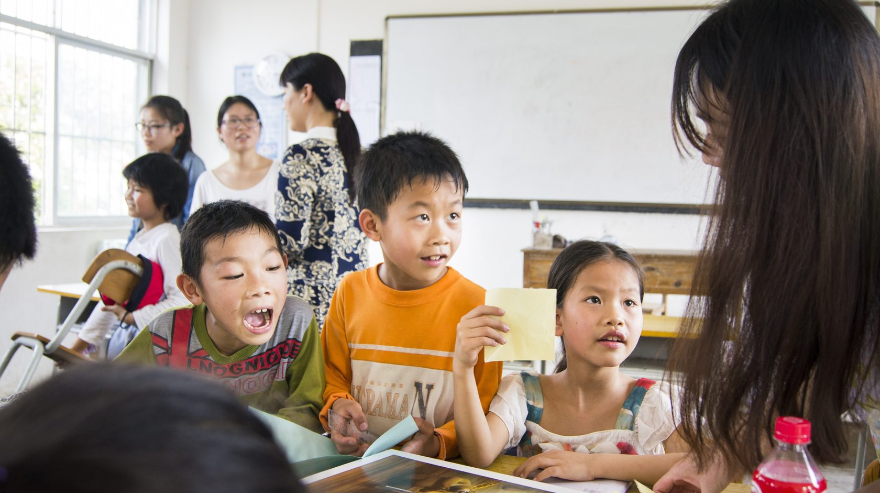
Willingness to Recommend VR Teaching
95% students are willing to recommend VR to others in their learning.
Particularly, female students and the Grade B&C group members are more likely to recommend.
The reason is that female students are more initiative in learning, while male students are more interested to play VR games; Grade B,C group members regard VR-base teaching a big help for them, thus willing to recommend.
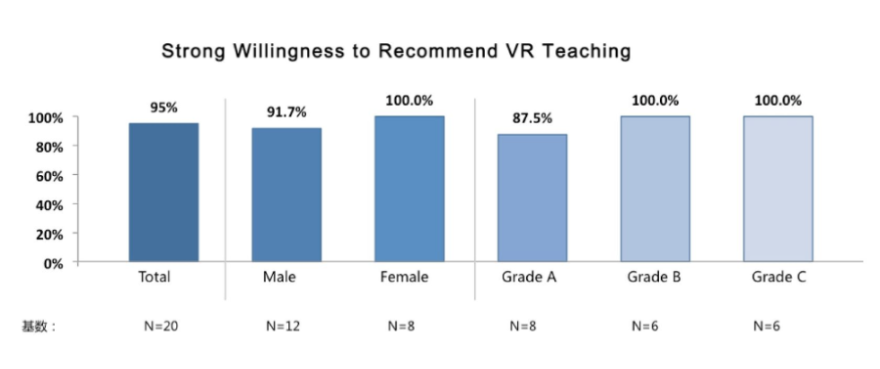
Conclusion
Even though VR has been in existence for decades, the integration and use of VR in education has only started to occur in recent years. Since VR has the potential to create a similar environment of the real world, it provides solutions for learning media and learning interaction. In teaching practice, personal experience is more convincing than abstract concepts. It provides an interactive medium instead of passive watching. VR can be used to form new learning context and increase student learning motivation. In addition, utilizing VR in education can reduce training costs significantly.
Academic performance refers to how a student meets the short-term or long-term goals in education. These included the amount of homework at home, distance of home from school, student teacher relationship, and teachers teaching experience and so on. Several factors are difficult to be controlled by learners. Quality of motivation is an important factor, which determine good academic performance. Because motivation directs behaviors toward a particular goal, it will improve academic performance as a result. Students who were most motivated in learning activities tended to become the highest achievers.
Every child is a genius in his or her own way. VR can be the key to awakening the genius inside.
Our own Altairika Virtual Encyclopedia contains more than 65 educational films on different subjects of school curriculum (astronomy, physics, biology, chemistry, anatomy, etc).
